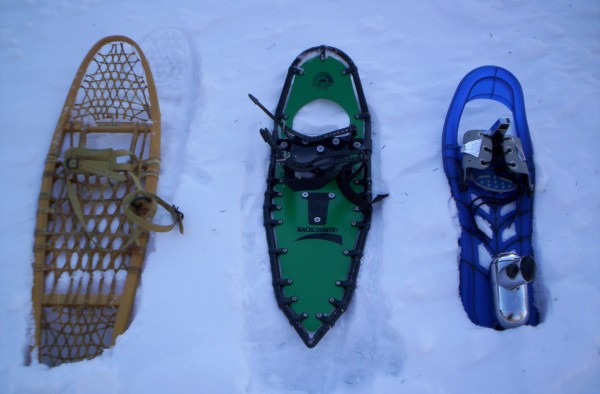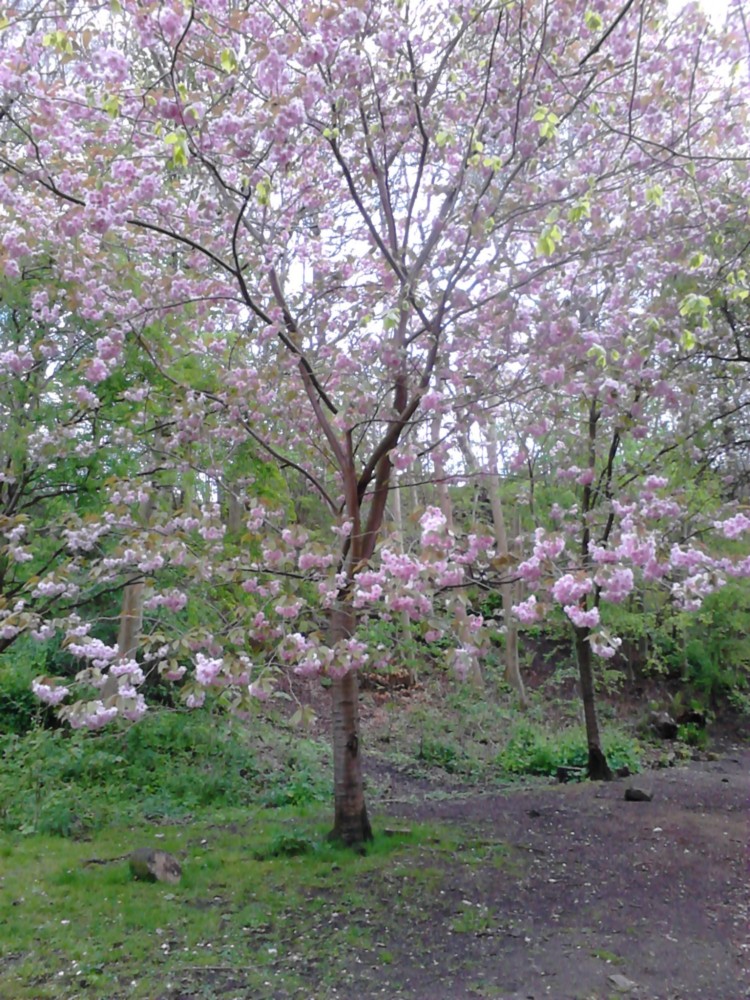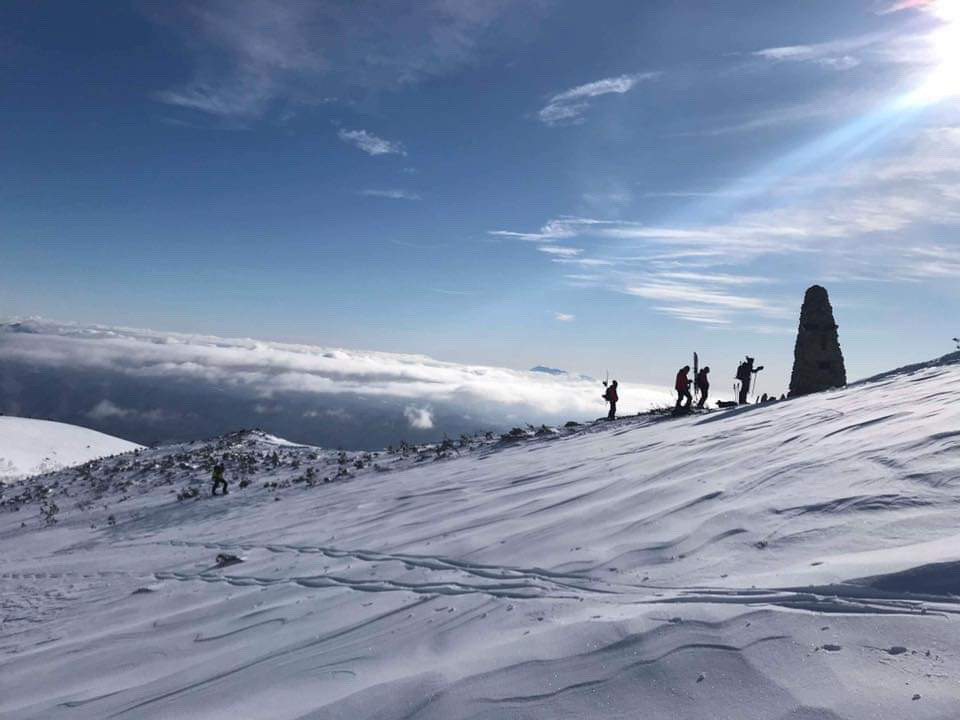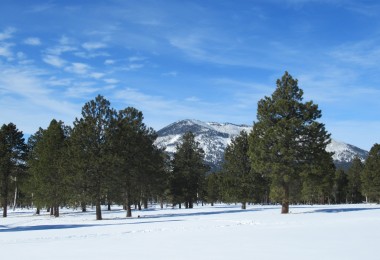Knowing the past and living in the present always leaves us wondering about the future. Knowing about the history of snowshoeing, and being actively involved in the sport today, activates the imagination to wonder what snowshoeing would be like in the future…let’s say 100 years from now. I will do just that, look at the future. But first, a short look at the past and present.
And the Rest was History
I enjoy stories about the history of snowshoeing, mainly because snowshoes had a profound impact in time given that once they were an essential form of travel in the northern hemisphere. Archeologists have traced the snowshoe back about 6,000 years, somewhere in Central Asia. Snowshoes at that time consisted of wooden slats with some type of hide strap for a binding.
Migration of the snowshoe then spread east and west. The shoe that moved west evolved as a long wood platform that became the ski in the countries of northern Europe, mainly because they moved across hills and valleys and through villages. In the east, historians believe the snowshoe migrated across the Bearing Straits and into North America, taking the shape of the shorter oval snowshoe that we are familiar with today.
Canada’s First Nations and Native Americans had a significant influence on snowshoes and snowshoe designs. According to the legendary and late snowshoe author Gene Prater (as edited by Dave Felkley) in Snowshoeing: from Novice to Master, the Athabasca Indians of the Northwest, Algonquin Indians of the Northeast and the Iroquois all brought the snowshoe “to the greatest peak of perfection.” They first created the bearpaw design and then came up with varying patterns of snowshoes suited for diversified conditions, such as elongated snowshoes designed to hunt buffalo on the plains.
 When the French settlers and voyageurs moved into the northern areas of North America, they used snowshoes for hunting and trapping, as well as for exploring, surveying and travel. Both natives and settlers usually made their own snowshoes designed on Indian patterns, according to Prater.
When the French settlers and voyageurs moved into the northern areas of North America, they used snowshoes for hunting and trapping, as well as for exploring, surveying and travel. Both natives and settlers usually made their own snowshoes designed on Indian patterns, according to Prater.
Since snowshoes in North America during the 18th through the 19th centuries were primarily used for survival, recreational snowshoeing did not come about until the mid-1800s. Prater wrote that the most active recreation organization of the time was the Montreal Snow Shoe Club of Canada, founded in 1840. They prided themselves on racing events, snowshoe hikes, and a strong social orientation based on the idea of good fellowship.
The concept of snowshoe clubs and community activities spread across eastern Canada and the New England United States well into the early 1900s. Although downhill skiing popularity passed snowshoeing interests during the post-World War II era, snowshoe interests gained popularity again in the late 1980s and continued to grow at a fast pace into the 21st century.
There’s Nothing Like the Present
Today, we still have the traditional snowshoe of varying styles, with wood frames made of ash and decks woven with either rawhide or neoprene webbing. The bearpaw, green mountain modified bearpaw, Main, Michigan or beavertail, Alaskan, and Ojibwa snowshoes continue to be sold on the market for those interested in back-to-basics snowshoeing.
The Aluminum frame snowshoe is the most popular shoe on the market today. They come in many sizes, shapes and styles to serve multiple conditions, just as the Native American of the past made wood-framed snowshoes of varying styles to adapt to conditions of their time.
Today however, modern snowshoes have decking made with Hypalon or other strong synthetic materials. These shoes have a symmetrical or asymmetrical shape, fixed or free rotation pivot system, small to large crampon traction devices, and more recently some have heel lifts. And, there are a myriad of binding styles that include clip, clasp, snap, buckle and ratchet that fastens around the heel, instep and toe to assure a tighter yet comfortable grip to the foot.
Popular lately too is the plastic injection-molded snowshoe, where the frame and deck are one large piece of lightweight and very strong plastic. Some styles have lateral traction devices in addition to the more common front and heel traction found on most aluminum-frame shoes. The plastic snowshoes tend to be less expensive and fairly lightweight.
There are also a few styles of metal-frame snowshoes on the market with decking similar to aluminum-frame shoes. They seem to be of interest to those looking for a long-lasting snowshoe that holds up to a beating because of their tough steel frame. They tend to be a heavier snowshoe however.
When you think of it, since the 1970s when the Sherpa Western style aluminum-frame snowshoe was first introduced by brothers, Gene and Bill Prater, the market has opened up a myriad of snowshoe styles over the past 40 plus years. However, many of the snowshoes today still maintain the basic western style (oblong-oval) design.
Back to the Future
So, let’s get back to looking at the future, and consider a creative look at snowshoes 100 years from now. How about snowshoes in 2112? When the imagination goes wild, here may be a few models we could see advertised in the future.
Kevlar Snowshoe with NASA flexible titanium bindings: This extremely lightweight snowshoe, weighing in at 10 ounces each, is so totally indestructible that even a moon-rover running over them would do nothing to alter it. The shoe would bounce back to its original shape. The bindings are made of an indestructible flexible titanium material used in space adventures and trips to the moon. It molds to your feet like a slipper and will never break.
Voice Activated Automated Snowshoes: Like Iron Man, with voice activation on the remote control module, the bindings clasp around your instep, across the heel and over the toe. On another command the crampons drop to the needed length, and the automatic heel lift drops down as you ascend a hill at the correct angle of the slope. This dynamic snowshoe offers the most advanced technology in voice command through a headset microphone.
The Segway 2100 Series Snowshoe: Now here is the latest in snowshoes for the laidback adventure snowshoer. Standing on your airlift snowshoes with a single staff to manage your balance, you are able to maneuver in any direction with a speed up to 10 miles per hour while gliding on the snow or hovering three to six inches above the snow. A heater sends warm air up from the shoe to warm the hiker, and a defrost system alters the density and condition of the snow underfoot. The solar-powered/snow-reflection battery allows the snowshoes to travel far distances without needing a charge.
The Enterprise Snowshoe: And finally, the ultimate in snowshoe technology is a shoe named after the classic and archived television/movie series, “Star Trek.” Equipped with high intensity lighting on its toes, this snowshoe allows you to be Captain Kirk at the helm by managing the direction, speed and maneuverability of up to six snowshoers hiking in areas where “no one has gone before.” All six members of your adventure party can be programmed to move robotically at the same pace and timing, getting you to your destination simultaneously.
Be it the flats of a wide open frozen lake or the mountains in the Rockies, these snowshoes at your command will allow you to move at variable speeds and ascend or descend areas without effort. It’s as if you have bionic lower extremities. And the final feature, when ready to exit the snow, is that with a given command you can be lifted from the snow (almost like being beamed-up by Scotty) to your space shuttle awaiting your arrival back to your home.
Okay…these may be exaggerated examples. But who knows what snowshoes have in store for us in the future. However, if you keep in mind that in 6,000 years the snowshoe went from a slab of wood with a rawhide binding to an aluminum frame snowshoe with polyurethane or plastic easy clip bindings, my guess is that the snowshoe will most likely not change too significantly in the next 100 years.
I do believe people will still have the pleasure of walking in snow at their leisure. The shoe may be made of different materials in the future. But I do not think we would be “beamed-up” following a snowshoe adventure.
I hope someone saves this article for 100 years so snowshoe enthusiasts can see how accurate I will be at that time. We will have to wait and see. We should also wait and see if Snowshoe Magazine is still being published in 2112. Hopefully it will…but most likely not by Ryan Alford. Perhaps it may be managed by his descendants.






Very complete. Well done…. I have a lot of miles on my wooden big wide long ones. ….Several winters ago, I over extended myself in searching for a cabin that had a snow machine inside it. The owner asked me to look at it and make him a offer. A snow storm blew up before I could get there. Time wise and all I turned and made my way home. In the proses over heated and became snow blind ( Having only one eye already ) and in a storm.. Thinking of taking shelter under a spruce tree and waiting till first light but no it was around 30` F. below zero. By now I was moving slow feeling my snow shoed path in about 5 feet deep snow. I could not see at all. It was dark but in the forest and my path was all I could feel. Taking 1/2 steps now inched my way up a mountain forest. I could feel the rises for each ridge I had to get over and to the top. 3 big climbs. Praying the trail would not be covered or that I fall off it and some way loose my bearings ( Mined you I was blind and in the dark besides ).. Snow shoed path was deep in this suggar snow so it would be some time before it would be leveled. I reached the summit, what a releaf but the bigger fear was the wind. Would the trail close in ? I had to keep going resting offten but only for moment at a time. Then finaly I was headed down, closer now to my dug out home and my worried wife. Rena who I had said see you tonight that was right after breakfast. Knowing the trail well now I was very close. I was about 50 feet away and I heard the dug out door open and a light, dim but a light. The words I heard were refreshing .. Thank God ! Then . Get in Here !. But I have to take off my snow shoes and my iced cloths. Again ! “Get in here ” Rena stuffed a warm cup of coco into my hands and undresed me part at a time. Rena did not know weather to kill me or hug me for the scare I had gave her..It was 4 A.M. I was exausted and colasped on the bed. You see I am the last Federal Homesteader to file and sign on the line. The 9′ x 11′ dug out was my habitable home tiil we could build a real log home. In any case I know about snow shoeing all to well in 5 feet of snow storm on a dark night being snow blinded.
Yours Truly D.A. Ose